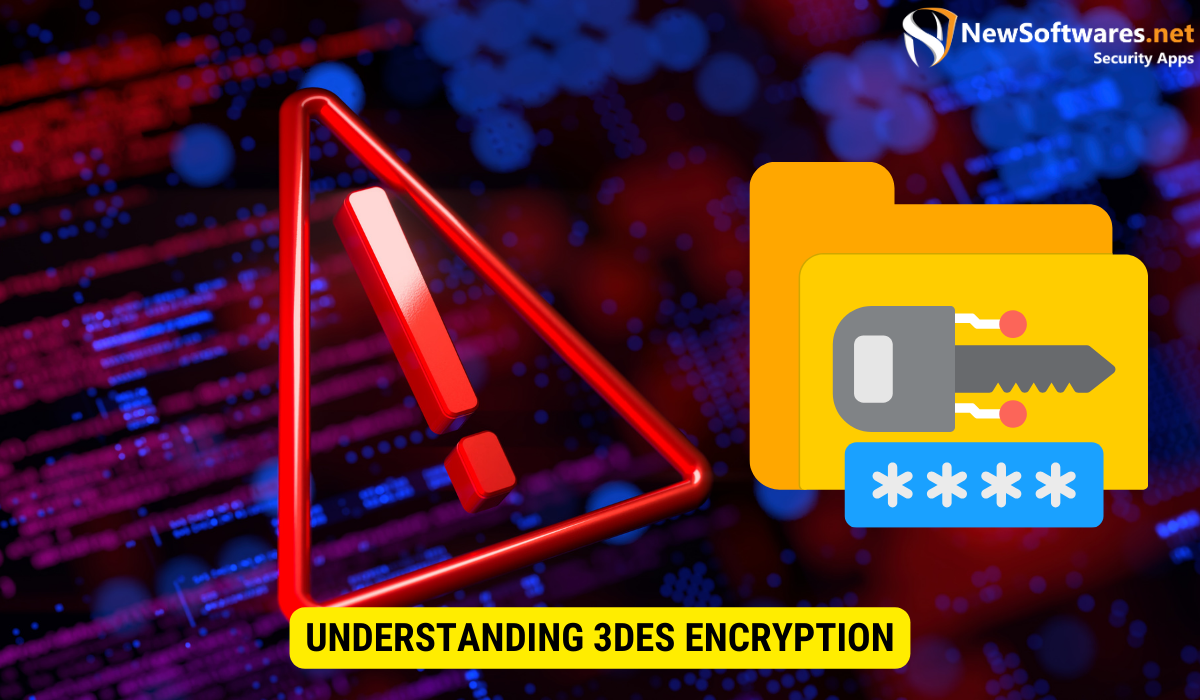Three Data Encryption Standard (3DES) is a symmetric encryption algorithm widely used in various applications to protect sensitive data. One important aspect of 3DES is the number of rounds it performs during the encryption process.
Understanding 3DES Encryption

To comprehend the number of rounds performed by 3DES, it is essential to have a basic understanding of how the algorithm works. 3DES is a block cipher that operates on 64-bit blocks of data. It uses a symmetric key of length 168 bits, which is derived from a 192-bit key. The primary goal of 3DES is to provide a higher level of security compared to its predecessor, the original Data Encryption Standard (DES).
The Basics of 3DES
At its core, 3DES is a type of Feistel cipher. In a Feistel cipher, the block of plaintext is divided into two halves, and a series of rounds are performed on these halves using a subkey derived from the main key. The results of each round are then combined to produce the ciphertext. This process is repeated multiple times to achieve stronger encryption.
Let’s take a closer look at the encryption process of 3DES. The initial step is the initial permutation, where the bits of the plaintext block are rearranged according to a specific permutation table. This step helps to ensure that the data is thoroughly mixed before the actual encryption begins.
After the initial permutation, the block is divided into two halves. The left half is denoted as L0, and the right half as R0. These halves are then subjected to a series of rounds, typically 16 or 24 rounds, depending on the variant of 3DES used.
Each round of 3DES involves three main steps: expansion, XOR, and substitution. In the expansion step, the right half of the block is expanded to match the size of the subkey. This expansion is achieved by duplicating and rearranging certain bits of the right half.
Next, the expanded right half is XORed with the subkey for that round. The subkeys used in each round are derived from the main key using a process called key scheduling. This ensures that each round has a unique subkey, adding an extra layer of security to the encryption process.
Once the XOR operation is complete, the result is passed through a substitution step. This step involves replacing certain bits of the result with others based on predefined substitution tables. The purpose of this step is to further confuse the data and make it harder for an attacker to decipher the encrypted message.
After the substitution step, the left and right halves are swapped, and the process is repeated for the next round. This swapping ensures that the encryption and decryption processes are symmetric, meaning the same algorithm can be used for both operations.
Finally, after completing all rounds, the left and right halves are combined to form the ciphertext. This ciphertext is the encrypted version of the original plaintext, and it can only be decrypted using the same key and the reverse process.
Key Components of 3DES
Before delving further into the details of the encryption process, it is important to understand the key components of 3DES. These components include the initial permutation, the subkeys used in each round, and the Feistel function.
The initial permutation is a crucial step in 3DES as it rearranges the bits of the plaintext block according to a specific permutation table. This permutation helps to ensure that the data is evenly distributed and mixed before the actual encryption begins. It adds an extra layer of misperception to the plaintext, making it harder for an attacker to analyze the data and break the encryption.
The subkeys used in each round of 3DES are derived from the main key using a process called key scheduling. This process involves applying various permutations and transformations to the main key to generate a set of unique subkeys for each round. These subkeys are crucial in the XOR operation, where they are combined with the expanded right half of the block to introduce randomness and strengthen the encryption.
The Feistel function is a fundamental component of 3DES. It performs the expansion, XOR, and substitution steps in each round. The expansion step expands the block’s right half to match the subkey’s size, ensuring compatibility with the XOR operation. The XOR operation combines the expanded right half with the subkey, introducing randomness and complexity to the encryption process. The substitution step further confuses the data by replacing certain bits based on predefined substitution tables.
By understanding these key components of 3DES, one can gain a deeper awareness into the algorithm’s inner workings and appreciate the level of security it provides. Combining the initial permutation, unique subkeys, and the Feistel function contributes to the robustness and effectiveness of 3DES encryption.
The Process of 3DES Encryption
The process of 3DES encryption involves several important steps that work together to ensure the security and confidentiality of data. Understanding these steps is crucial for implementing and utilizing 3DES effectively.
Initial permutation in 3DES
Before the encryption process begins, an initial permutation takes place. This permutation rearranges the bits of the input block, ensuring that the data is shuffled deterministically. By doing so, the initial permutation provides a crucial foundation for the subsequent encryption steps.
During the initial permutation, each bit of the input block is carefully repositioned according to a predefined pattern. This pattern is designed to achieve two important goals: Diffusion and confusion. Diffusion refers to spreading the input data’s influence throughout the entire encryption process, making it difficult for an attacker to analyze and predict the effects of any specific input bit. Confusion, on the other hand, refers to transforming the input data in a way that makes the relationship between the input and output bits complex and non-linear, further enhancing the security of the encryption algorithm.
The Role of Subkeys in 3DES
In each round of 3DES, different subkeys are generated from the main key. These subkeys play a crucial role in transforming the halves of the input block during the encryption process. Generating unique subkeys for each round is a key aspect of 3DES that enhances the overall security of the algorithm.
The subkey generation process involves applying various mathematical operations to the main key, resulting in a set of unique subkeys to each round. These subkeys are then used to modify the input data, adding an additional layer of complexity and security to the encryption process. By using different subkeys in each round, 3DES confirms that even if an attacker manages to compromise one round’s subkey, they cannot use it to decrypt other rounds or gain access to the original data.
The Function of Feistel Function in 3DES
The Feistel function is a key component of the encryption process in 3DES. It is responsible for applying various operations to the input data, transforming it to ensure the confidentiality and integrity of the encrypted information.
The Feistel function in 3DES performs a series of operations, including expansion, permutation, substitution, and XOR. Expansion involves increasing the size of the input data, creating additional bits that are used in subsequent operations. Permutation rearranges the bits of the expanded data according to a predefined pattern, further enhancing the diffusion and confusion properties of the encryption algorithm. Substitution replaces certain bits of the permuted data with different bits based on predefined substitution tables. Finally, XOR (exclusive OR) combines the permuted and substituted data with the subkey for that round, producing the final output for that round.
By applying these operations in a carefully designed manner, the Feistel function ensures that the plaintext is mixed and transformed sufficiently to produce ciphertext that is resistant to cryptanalysis attacks. The complexity and non-linearity introduced by the Feistel function make it extremely difficult for an attacker to reverse-engineer the original plaintext from the ciphertext, providing high security for the encrypted data.
The Number of Rounds in 3DES Encryption
Defining a Round in 3DES
A round in 3DES consists of multiple iterations of the encryption process. Each iteration involves applying the Feistel function to the input block using a specific subkey. The number of iterations performed in a round depends on the mode of operation used.
The Importance of Multiple Rounds

Multiple rounds are vital in 3DES to achieve a higher level of security. Each round adds complexity and Diffusion, making it more difficult for attackers to break the encryption. The number of rounds directly affects the strength of the encryption and the time required to perform the encryption.
Calculating the Number of Rounds in 3DES
The number of rounds performed by 3DES depends on the mode of operation and the desired level of security. The most common combination is the Triple Data Encryption Algorithm (TDEA), which uses three different keys and performs 48 rounds.
The Impact of Rounds on 3DES Encryption
How Rounds Affect Encryption Strength
Increasing the number of rounds in 3DES enhances the security of the encryption. Each additional round introduces more complexity and Diffusion, making it harder for attackers to break the encryption. However, it is important to strike a balance between security and performance, as adding more rounds also increases the computational overhead.
The Relationship Between Rounds and Processing Time
As the number of rounds increases in 3DES, the processing time required for encryption also increases. This is because each round involves multiple iterations of the Feistel function, which requires additional computational resources. When implementing 3DES in a system, it is crucial to consider the trade-off between security and processing time.
The Security of 3DES Encryption

Evaluating the Security Level of 3DES
Although 3DES has been widely used for many years, its security level is no longer considered as robust as that of more modern encryption algorithms. Advances in computing power and cryptanalysis techniques have rendered 3DES susceptible to certain attacks. As a result, many organizations have transitioned to more secure encryption algorithms, such as the Advanced Encryption Standard (AES).
The Vulnerabilities of 3DES Encryption
3DES has several known vulnerabilities, including the “Sweet32” attack, which exploits the small block size of the algorithm. Additionally, due to the increased processing power available to attackers, brute-force attacks on 3DES have become more feasible. These vulnerabilities highlight the importance of transitioning to more secure encryption algorithms.
Key Takeaways
- 3DES encryption operates in rounds, with either 16 or 24 rounds being typical.
- Multiple rounds increase encryption strength by adding complexity and diffusion.
- TDEA, a variant of 3DES, performs 48 rounds using three different keys.
- 3DES has known vulnerabilities, prompting a transition to more secure encryption algorithms.
- Balancing security and processing time is crucial when choosing the number of rounds in 3DES encryption.
FAQs
Q1: How does 3DES encryption work?
A1: 3DES is a block cipher that divides data into halves, applies a series of rounds with subkeys, and uses operations like expansion, XOR, and substitution to create ciphertext.
Q2: What is the purpose of multiple rounds in 3DES?
A2: Multiple rounds in 3DES enhance encryption strength by adding complexity and diffusion, making it more resistant to attacks.
Q3: How many rounds are performed in Triple Data Encryption Algorithm (TDEA)?
A3: TDEA, a common 3DES variant, performs 48 rounds, utilizing three different keys.
Q4: Are there any vulnerabilities in 3DES encryption?
A4: Yes, 3DES has vulnerabilities, such as the “Sweet32” attack and susceptibility to brute-force attacks, making it less secure compared to modern encryption algorithms.
Q5: What are the implications of the number of rounds on processing time in 3DES?
A5: Increasing the number of rounds in 3DES also increases processing time, so organizations must balance security and performance when implementing it.
Conclusion
In conclusion, the number of rounds performed by 3DES depends on the mode of operation and the desired level of security. Implementing more rounds increases the complexity and Diffusion, enhancing the strength of the encryption. However, the trade-off between security and processing time must be carefully considered. As advances in cryptanalysis techniques continue, it is essential for organizations to transition to more secure encryption algorithms to protect their sensitive data.
